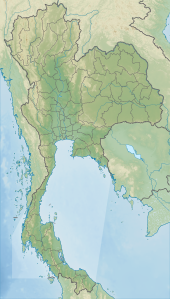|
Kaeng Krachan National Park
Kaeng Krachan National Park (Thai: อุทยานแห่งชาติแก่งกระจาน, RTGS: Utthayan Haeng Chat Kaeng Krachan, pronounced [ʔùt.tʰā.jāːn hɛ̀ŋ t͡ɕʰâːt kɛ̀ŋ krā.t͡ɕāːn]) is the largest national park of Thailand.[1][2] It is on the border with Burma, contiguous with the Tanintharyi Nature Reserve. It is a popular park owing to its proximity to the tourist town of Hua Hin. It was named a UNESCO World Heritage Site on 26 July 2021,[3][4] despite concerns from the OHCHR around the human rights violations of the indigenous people that live in the park.[5] Geography The park covers parts of the districts Nong Ya Plong, Kaeng Krachan, and Tha Yang of Phetchaburi Province, and of Hua Hin of Prachuap Khiri Khan Province. It consists mainly of rain forest on the eastern slope of the Tenasserim Mountain Range. The highest elevation in the park is 1,513 meters, in a "joint area of Thailand and Myanmar". The second highest mountain peak is Kao Panern Toong with an elevation of 1,207 m.[2] Two main rivers originate within the park area, the Pranburi River and the Phetchaburi River. The Phetchaburi is impounded by the Kaeng Krachan Dam at the eastern border of the park. The dam creates a lake covering an area of 46.5 km2. The dam was built in 1966. HistoryThe park was declared a reserve in 1964 and on 12 June 1981, it became the 28th national park of Thailand. Originally covering an area of 1,548,750 rai ~ 2,478 square kilometres (957 sq mi), it was enlarged in December 1984 to include the boundary area between Phetchaburi and Prachuap Khiri Khan Provinces, an additional 273,125 rai ~ 437 square kilometres (169 sq mi).[6] The park has been included on the list of ASEAN Heritage Parks. It is part of the Kaeng Krachan Forest Complex, which the Thai government had repeatedly nominated for designation as a World Heritage Site since 2011. At its 2019 meeting, UNESCO's World Heritage Committee (WHC) rejected Thailand's third bid, citing outdated information regarding boundaries and a lack of local community participation.[7] In July 2021 Thailand made its fourth application for World Heritage Site recognition.[8] On 26 July 2021, the 21 nations of the UNESCO World Heritage Committee voted 12–9 to approve Kaeng Krachan's listing as a World Heritage Site.[3] The killing of wild elephants is an ongoing problem at the park,[9] with authorities unable to control poachers.[10] Some park officials are allegedly involved in the trade of elephant parts.[11] Despite national park status, there are private plantations within the confines of Kaeng Krachan National Park. Some of these are surrounded by electric fences which, in June 2013, fatally electrocuted an elephant calf.[12] In 2018, the park started taking bids on a project to pave 18.5 kilometres of the Bang Krang to Phanoen Thung Road. It is budgeted at 87.62 million baht. The existing one-lane dirt road is "broken beyond repair" according to the park's chief. Environmentalists oppose the project on the grounds that easier accessibility will mean more tourists in the fragile ecosystem.[13] The park chief says, "...the project does not violate regulations...and [we have] a duty...to proceed with the project."[14] The project was halted, at least temporarily, in early-November 2018 by the National Parks Department to allow opponents to be heard on the issue.[15][16] Flora and faunaThe forests contain a great biodiversity of tropical vegetation, including tropical and subtropical broad leaf tree species and palms. Ninety-one species of mammals and 461 bird species have been counted in the park.[1][17]
Wild fruitsThe following wild fruits are found in Kaeng Krachan National Park.[18]
See also
References
External linksWikimedia Commons has media related to Kaeng Krachan National Park. |
||||||||||||||||||||||||||||||||||||||






